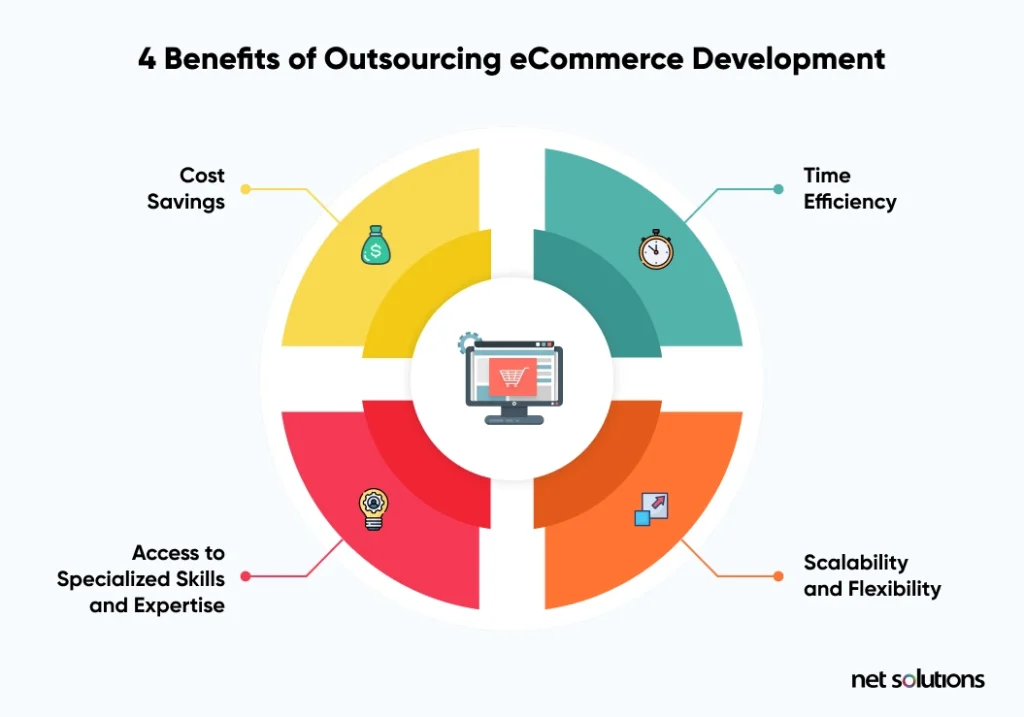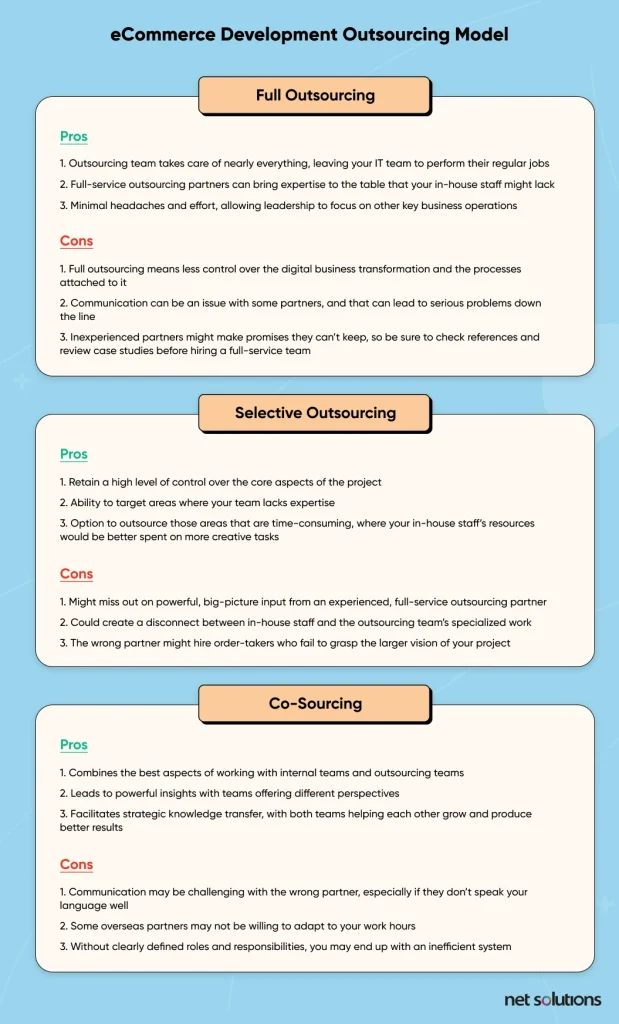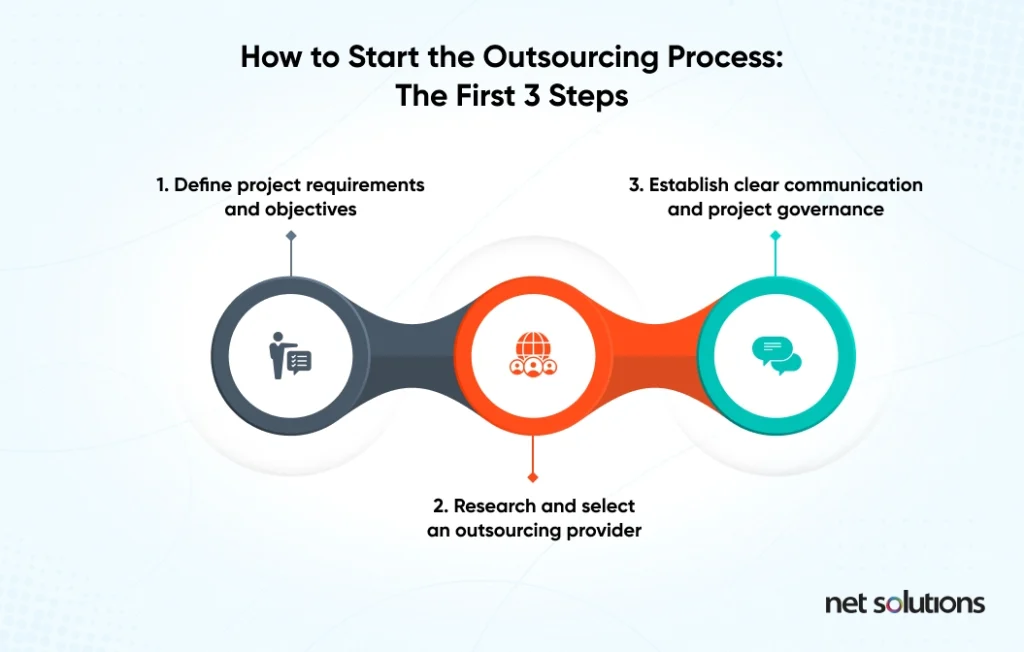Online shopping is big business, and the eCommerce market is expected to grow to over $80 trillion by 2026—with 91% of consumers regularly shopping online.
Winning conversions, earning repeat business, and building a powerful online enterprise begins with technology, and eCommerce companies are using outsourcing partners to help them address a wide range of tech needs.
If you’re considering outsourcing any portion of your eCommerce website’s design, development, maintenance, or improvements, this is the guide for you.
Read on to learn about the pros and cons of outsourcing, different outsourcing models, and the initial steps you should take if you’re interested in finding and hiring a talented outsourcing partner.
What is eCommerce Outsourcing?
Outsourcing eCommerce projects means hiring a third-party software development company to handle tasks such as design, web development, project management, Quality Assurance (QA), User Experience (UX), site maintenance, and anything else related to online retail technology.
Online businesses may choose to outsource all their eCommerce operations and technology projects to a third-party partner vendor, or they may choose to divide tasks between an outsourcing partner and their in-house team.
Outsourcing can be a cost-effective way to run an eCommerce business, providing flexibility and scalability to meet your business needs.
What is the difference between offshoring and outsourcing?
You may hear people using the terms offshoring and outsourcing interchangeably, but that’s not always correct. Outsourcing describes working with third-party development services, while offshoring refers to hiring outsourcing companies in distant countries.
In other words, while all offshoring is outsourcing, some outsourcing is not considered offshoring, since a company might hire a local development team (onshoring) or a team in a nearby country (nearshoring) for their development projects.
| Outsourcing Definition | Hiring a business partner to handle any aspect of your technology needs, such as software design and development, Quality Assurance, project management, etc. |
| Offshoring Definition | Outsourcing any technology tasks to an overseas partner, usually in a distant country. |
Outsourcing Definition
Outsourcing is the act of hiring a third-party development team to provide services that you would otherwise task to an in-house development team.
Offshoring Definition
Offshoring is a type of outsourcing that refers to hiring third-party developers in far-away countries, such as a U.S. company contracting with outsourcing partners in India or the Philippines.
Take a look at our comprehensive analysis of worldwide outsourcing rates in 2024 to see why offshoring is an attractive option for many eCommerce companies.
4 Benefits of Outsourcing eCommerce Web Development
When people think about outsourcing, the first benefit that often comes to mind is cost savings. And while you can save a great deal of money through outsourcing for a variety of reasons, that’s only part of the equation.

Hiring an experienced, talented software development team to build and manage your online store has a number of additional benefits, including efficiency, scalability, and gaining access to specialized skills that your in-house team might currently lack.
1. Cost savings
Outsourcing is typically more cost-effective than hiring an in-house team, especially if you hire a partner from overseas, where labor costs are often lower due to variations in the cost of living across the globe.
Even when you remove cost-of-living from the equation, however, outsourcing often ends up a more cost-effective solution because business owners don’t have to cover payroll taxes, benefits, and other expenses associated with full-time employees.
Also, you don’t have to pay for downtime when things get slow, and you aren’t subject to a series of lay-offs and rehires as your company grows in starts and fits. Hiring and rehiring will add to your overhead and cost you dearly.
2. Access to specialized skills and expertise
When building an in-house development team, eCommerce companies typically start by hiring for the skills they most need at the time. This makes more sense than hiring for every specialization because, if they took that approach in the beginning, they would end up overstaffed.
What happens, however, is that in-house teams often end up with gaps in their overall skill set, and overworked engineers end up engaging in tasks that they’re not fully equipped to perform.
That’s why many online retailers turn to eCommerce outsourcing companies. They can screen potential partners for the exact skill sets and eCommerce services they require, and they can allow their in-house team to support their core business efforts—doing what they do best.
3. Time efficiency
Outsourcing can be a great deal more efficient than relying exclusively on an in-house team.
First, the in-house hiring process takes a long time. Secondly, when projects and tickets start to pile up, both fast-moving startups and enterprise retailers can turn to outsourcing partners to expedite the process.
Another advantage of working with a remote team in a distant country is that your teams can work asynchronously if you’d like. In other words, one team can work while the other team, on the opposite side of the globe, is sleeping.
At Net Solutions, we did exactly that for Kitco, whose engineers wrote code during their local business day, and when they woke up the next day, our QA team gave them a list of all the bugs they needed to address.
Of course, a good offshoring partner will also adapt to your work hours if that’s what you prefer. That’s what we did for Soaq, a Canadian company with a video e-learning platform that we built.
4. Scalability and flexibility
What happens when your eCommerce store produces mountains of revenue, and you decide to expand your offerings and hire new employees?
That’s a great problem to have, but it’s also a scary one if you’re not equipped to scale and you need to expand your tech capabilities overnight.
That’s where working with an outsourced eCommerce website development company can help. Rather than hiring new in-house staff, which takes a great deal of time, you can simply call up your full-service outsourcing partner and hire them to perform additional services.
Of course, in all things business, you should work for success while planning for unpleasant contingencies. In the event that business slows, you can reduce the number of services—making outsourcing a highly flexible option.
eCommerce Development Outsourcing Models
Outsourcing isn’t always a matter of turning over everything, from design to development to project management, to an outside organization. That’s just one model of outsourcing called “full outsourcing.”
Depending on your business needs, you might choose to outsource only specific tasks to a team overseas, which is known as “selective outsourcing.” Alternatively, you might choose a collaborative approach called “co-sourcing,” where your in-house team works side-by-side with a partner that might be on the opposite side of the world.

Let’s explore these three approaches to outsourcing in greater detail.
Full outsourcing
Full outsourcing means giving your entire project over to a third-party design and development team. The full-service outsourcing partner will handle project management, website design, development, UX, QA, security, and everything else you need.
The beauty of this model is that you don’t have to hire any in-house staff to handle technology needs, and a trusted partner can deliver high-quality results—turning to you for input and general guidance on what you need them to do.
Of course, this model also means you’re giving up a certain degree of control. That’s fine if you work with a partner who keeps you informed and has systems to communicate their progress.
Now, in the wrong hands, an inexperienced web development company could fail to deliver an eCommerce site that addresses your business needs.
Full Outsourcing Pros and Cons
| No need to hire in-house tech staff | Loss of control |
| Reduced communication challenges since team members all work for the same organization | An ineffective partner may not communicate well with you |
| Hassle-free and hands-off—if you hire the right partner | The wrong partner might fail to deliver what you want, and you might realize too late that they’re going down the wrong path |
Selective (partial) outsourcing
Do you have a strong core team with a clear vision of what they want, but find them lacking in the time or expertise needed to build or maintain every aspect of your eCommerce site?
If that’s your situation, selective or partial outsourcing may be a good option for you. Selective outsourcing involves hiring outsourcing partners for specific tasks, such as QA or security maintenance.
This model leaves you with near complete control over the core missions of the project, and it works well to supplement areas where time or expertise is lacking. On the downside, you may miss out on the insight that an experienced, full-service team has to offer—from project management guidance to design and UX insights.
Selective Outsourcing Pros and Cons
| Retain a high level of control over the core aspects of the project | Might miss out on powerful, big-picture input from an experienced, full-service outsourcing partner |
| Ability to target areas where your team lacks expertise | Could create a disconnect between in-house staff and the outsourcing team’s specialized work |
| Option to outsource those areas that are time-consuming, where your in-house staff’s resources would be better spent on more creative tasks | The wrong partner might hire order-takers who fail to grasp the larger vision of your project |
Co-sourcing
Co-sourcing is similar to selective or partial outsourcing because you’re sharing tasks between an in-house team and an off-site partner. However, co-sourcing involves more of a two-way collaboration between the outsourcing partner and internal staff.
In other words, rather than assigning specific tasks like QA or back-end coding to the partner while the in-house team takes charge of everything else, a co-sourcing model integrates project management, planning, and other big-picture activities. They come together as a team, just like an in-house team would do.
Co-sourcing combines the best aspects of in-house teams and external teams. By sharing responsibilities, teams can work together to produce amazing results and ensure strategic knowledge transfer.
One potential disadvantage to co-sourcing is that it may be challenging to establish clear roles and responsibilities without strong project management skills.
Also, communication may be challenging if your offshore partner is not willing to work within your time zone, or if you don’t set up solid processes for collaboration (such as regular Zoom meetings and adherence to project management best practices).
Whichever model you decide to employ, base your decision on your current resources and business needs. Discuss these models with key stakeholders and leadership, and explore your options to make an informed decision.
Co-sourcing Pros and Cons
| Combines the best aspects of working with internal teams and outsourcing teams | Communication may be challenging with the wrong partner, especially if they don’t speak your language well |
| Leads to powerful insights with teams offering different perspectives | Some overseas partners may not be willing to adapt to your work hours |
| Facilitates strategic knowledge transfer, with both teams helping each other grow and produce better results | Without clearly defined roles and responsibilities, you may end up with an inefficient system |
Whichever model you decide to employ, base your decision on your current resources and business needs. Discuss these models with key stakeholders and leadership, and explore your options to make an informed decision.
How to Outsource eCommerce Development: First Steps
How do you go about hiring an outsourcing partner?

We’ve written a definitive, step-by-step checklist for hiring an outsourced development team, and when you’re ready, you’ll want to refer to it. For now, the following three steps will get you started down the path of finding the perfect team to build your eCommerce solution.
Define project requirements and objectives
What are you hoping to achieve with your eCommerce store and related projects?
If you don’t know where you’re going, you’re going to have a hard time getting there, so outlining your requirements and objectives is vital.
- What is your timeline for launch?
- What is your budget?
- What risks might you encounter that prevent you from achieving your goals?
- Are you planning to use a SaaS eCommerce platform like Shopify, or do you want to build your own custom online store using an eCommerce platform like Magento?
- Are you interested in creating a mobile app to accommodate online shoppers, or will they just access the mobile version of your website?
- What digital marketing features do you want to integrate into your online store?
- How will you approach your marketing strategy?
- What outsourcing model will your outsourcing team provide?
This is by no means a comprehensive list—far from it! Instead, it should get you thinking about your big-picture approach and how your efforts will fit into the ultimate goal of winning conversions and building a powerful online business.
Research and select an outsourcing provider
Selecting the right outsourcing partner can make or break your project—and even your business—so don’t take that decision lightly!
When searching for an outsourcing partner, consider the following criteria:
- Expertise in the technologies you need
- Experience in eCommerce (Hint: Look at their case studies)
- Communication skills
- Flexibility and willingness to accommodate your needs
You can use an RFP to find the right eCommerce partner, or you can reach out directly to any team of professionals whose track record you find impressive.
Once you’ve identified potential partners and narrowed it down to a shortlist, conduct interviews and ask the tough questions that will get you the answers you need. Ask about their experience, project management skills, communication approach, methodologies used (e.g., Agile Scrum), and other business processes.
Establish clear communication and project governance
Before you hire a team of developers, clearly define the roles that both your in-house team and your outsourcing partners will play. Don’t even think about signing a contract until you can clearly answer the following questions.
- Who will handle project management?
- How often will project managers or lead developers check in with you?
- How much autonomy does your outsourcing team have to make key decisions?
- What roles will they play in areas outside of development, such as design, QA, security, website maintenance, and others?
The pointers above are meant to get you thinking and move you in the right direction before signing a contract. For further guidance, you can refer to our ultimate outsourcing guide.
Need Help With eCommerce Development?
Net Solutions has worked with eCommerce leaders such as 2XU and American Golf, helping to create modern, fully customized online stores that maximize conversions.
Whether you’re an eCommerce enterprise, a startup, or somewhere in between, we can help your business serve its customers and scale strategically.
Ultimately, the best choice is not just about cost, it’s also about what is best to support your business needs.

![Header Image_Why Outsource Your eCommerce Development in 2025 [Guide]](https://www.netsolutions.com/wp-content/uploads/2023/11/Header-Image_Why-Outsource-Your-eCommerce-Development-in-2025-Guide.webp)



